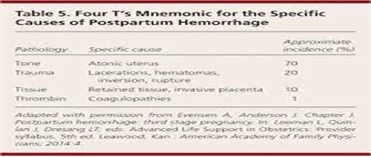Which of the following patients is most at risk for uterine rupture?
A G3P2 whose youngest child is 3 years old.
A G2P1 who has had one prior lower transverse cesarean section.
A CS4 who has had three prior lower transverse cesarean sections.
AG4P3 whose last baby was born at term gestation.
The Correct Answer is C
A CS4 who has had three prior lower transverse cesarean sections is at the highest risk for uterine rupture. The risk of uterine rupture increases with each subsequent cesarean section, and a history of three or more prior lower transverse cesarean sections is considered a significant risk factor for uterine rupture.
Nursing Test Bank
Naxlex Comprehensive Predictor Exams
Related Questions
Correct Answer is D
Explanation
The most common cause of excessive blood loss after childbirth is the failure of the uterine muscle to contract firmly, which is also known as uterine atony. If the uterus does not contract effectively after delivery, it cannot properly close off the blood vessels that were connected to the placenta, leading to heavy bleeding. Uterine atony can occur due to various factors, such as prolonged labor, multiple births, or the use of certain medications during labor.
Other causes of excessive blood loss after childbirth include retained placental fragments, vaginal or vulvar hematomas, or unrepaired lacerations of the vagina or cervix, but these are less common than uterine atony.

Correct Answer is C
Explanation
Health literacy is defined as the degree to which an individual can obtain, process, and
understand basic health information and services needed to make appropriate health decisions. Basic functional health literacy refers to an individual's ability to read and understand simple health information and instructions.
While all the clients mentioned may be demonstrating health literacy, the ability to read and understand discharge instructions after routine surgery is a basic functional health literacy skill. This client is able to comprehend written health information and follow simple instructions, which is an important aspect of managing their own health care.
The other clients mentioned may be displaying a higher level of health literacy, such as the client who is teaching a class about cancer survival or the client with Type II Diabetes who is using nutritional information to make a grocery list. These individuals may have a greater ability to understand and apply complex health information and navigate the healthcare system.
Whether you are a student looking to ace your exams or a practicing nurse seeking to enhance your expertise , our nursing education contents will empower you with the confidence and competence to make a difference in the lives of patients and become a respected leader in the healthcare field.
Visit Naxlex, invest in your future and unlock endless possibilities with our unparalleled nursing education contents today
Report Wrong Answer on the Current Question
Do you disagree with the answer? If yes, what is your expected answer? Explain.
Kindly be descriptive with the issue you are facing.
